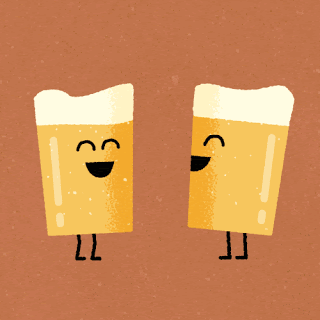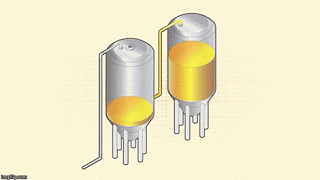Beer is the simplest and most complex of beverages, all at once.Simple enough that the first beer was probably an accident. Grain, water and wild yeast from the air combined by chance and fermented. Some brave passer-by tasted the foamy result and was no doubt amazed at its intoxicating effect. By 4,000 BC, the Sumerians had perfected ways to replicate that miraculous process.

Simple, because it is made from as few as four ingredients: grain, water, hops and yeast. But beer is also complex. Given those few ingredients, brewers have crafted seventy or more distinct beer styles and thousands of individual interpretations. By varying the amounts or characteristics of the four ingredients and also by adding new ingredients or by altering even a little timing or temperature of the brewing process, master brewers have created an astounding variety of beers that you drink.
How is Beer Brewed?
In the broadest sense, “beer” is an alcoholic beverage made by the fermentation of grain. Similarly wine is an alcoholic beverage made by the fermentation of fruit. In vast majority barley is the grain base for the beers brewed worldwide.While most of us love beer, few of us know exactly how it is made.
Step 1: Milling the grain

The first thing a brewer needs to do before getting to making of beer is to ensure that their brewing grain is ready to go. Assuming they aren’t malting their own barley, this means milling or crushing the grains. This crucially important step can make or break a beer before it has even begun. The key is to crush the grains enough so that it exposes the starchy center of the barley seed without damaging the grain hulls that encase them.
If The Crush Is Too Course, Not Enough Of The Starch Will Be Converted To Fermentable Sugars. If The Crush Is Too Fine, Then The Husk Which Acts As A Filter Bed For The Brew Will Be Destroyed And The Brew Will Become Gummy And Unusable. Different Types Of Malt Are Crushed Together To Break Up The Grain Kernels In Order To Extract Fermentable Sugars To Produce A Milled Product Called Grist.
Step 2: Mash Conversion

The grist is then transferred into a mash tun, where it is mixed with heated water in a process called mash conversion. That’s when the magic starts to happen. The heat from the water (referred to as liquor in breweries) activates the enzymes within the barley. These enzymes then begin to convert the starches in the grains into sugars.
Since there are several different types of enzymes within barley, each with a preferred temperature at which they like to work, brewers monitor these mash temperatures extremely closely. By raising and lowering the temperature of the mash, brewers can control what types of sugars are produced by the enzymes. At lower temperatures, highly fermentable sugars are created resulting in dry beers. At higher temperatures, the sugars are not as easily digested by the yeast resulting in a beer with some sugars left unfermented and thus a sweeter and more full-bodied end product. The enzymes work quickly too. Within about an hour they will be done converting starch into sugar, at which point the brewer will end the enzymatic activity by raising the temperature of the mash to over 200 degrees Fahrenheit, a process known as mashing out.
Step 3: Lautering

The next step in the brewing process is the take the mash and separate out the spent grain from the sugary liquid known as wort (pronounced wert). This process is called lautering. To begin the lautering process, the mash is transferred to a vessel with false-bottom called as lauter tun. Here the clear wort is drained away from the hulls and barley grist.
Water is also added during lautering in order to extract even more of the fermentable sugars from the grain. This is known as sparging. Sparging must be done very gradually so as to not disrupt the grain bed that acts as a natural filter for the wort. Brewers typically add sparge water at the same rate as the wort being drained below. Although some English brewing methods call for complete draining of the wort and then adding water and repeating the process. This second go-round of lautering is called second runnings and was historically made for small beers. Brewers must be careful not the sparge for too long as eventually the bitter tannins from the grain will also be stripped away.
Step 4: The Boil

Once the sweet wort has been separated from the grains, it is brought to a strong prolonged boil for one to two hours. This boiling process is critical for many reasons. From a historical point, most importantly it sterilizes the beer. In today’s modern world that seems fairly important but for a long time this was quite literally a life-saver.
For centuries people co-mingled their clean and run-off water supplies leading to their drinking water becoming a town-well-sized petri dish for harmful bacteria. Of course people didn’t understand this. They just knew the water was unsafe, and that something in the brewing process made the water okay to drink. It is for this reason that everyone drank beer including small children. Boiling does more than sterilize the brew, however Hops introduced to boiling water will begin to break down or isomerize, molecularly altering the composition of the acids within the hops and releasing bitterness into the beer. The longer the hops are boiled, the more alpha acids will be isomerized in order to lend bitterness to the brew. Hops added to the boil to lend bitterness are called early hop additions and are generally allowed to boil in the beer for an hour or more. Hops added later in the boil do not create bitterness to the beer all that much but instead lend flavor and aroma. This is because in addition to alpha acids, hops also contain highly volatile and very pungent oils which break down quickly in boiling water. However if only exposed to the boiling wort for a short period of time or at lower temperatures, hops will release these oils and lend aromatics and flavor to the beer. To extract flavor, brewers typically add hops about 10-15 minutes before the end of the boil. For aroma, hops are added even later, no more than 2 minutes before the end of the boil. Often aromatic hop additions are done even after the boil ends.
Step 5: Wort separation and cooling

Once the boil is completed it is sent to a whirlpool to collect any hop matter and coagulated proteins that have accumulated. Then it is immediately cooled. Cooling the beer quickly is important since the beer will begin to oxidize and produce off flavors almost immediately at these temperatures.
At this stage any residue malt or hop particles are removed to leave the liquid that is ready to be cooled and fermented.
Step 6: Fermentation

Once the wort has been cooled, it is moved to a fermentor which is usually just a large stainless steel vat or in rare cases in oak vats. Next yeast is added and the fun begins. From the moment the yeast is added, it gets to work eating the sugars that were created during the mash. As they consume the sugar, the yeast expels out carbon dioxide and alcohol as well as a variety of flavor compounds that vary and are greatly depending on several variables such as the specific strain of yeast and fermentation temperature of the beer. Fermentation time can vary greatly from a few days for simple ale to over a month for lagers.
Fermentation is also where the brewer decides whether or not he/she will be brewing an ale or a lager. This decision is a simple choice of using lager yeast or ale yeast, although the brewing of the beer changes drastically depending on which direction the brewer goes. If brewing an ale, which account for the majority of beers by style, the brewer will pitch ale yeast and let the temperature of the fermenting beer rise to a toasty 65-76 degrees – perfect for ale yeast. Also called top-fermenting yeast, ale yeast forms a thick layer pillow foam at the top of the fermentation vessel. This is called a kräusen or pellicle and if you didn’t know any better, you’d think it would kill you if you drank what was underneath it. But rest assured, there are no byproducts of beer, wanted or unwanted, that will hurt you (besides alcohol of course). This is a main reason why home brewing is legal in most of the countries. The worst you can do is make a gross tasting beer! Ale yeast forms a high krausen in an open fermentor If brewing a lager, the brewer must keep the beer much cooler, usually between 45 and 55 degrees. At these temperatures the lager yeasts works slowly and efficiently towards producing a clean tasting beer with little flavors given from the yeast itself. Unlike ales, lagers yeast or bottom fermenting yeast, do not form a pellicle at the top of the fermentation vessel.
Step 7: Maturation

Once the yeast has consumed all the available sugars, primary fermentation is over. While the beer is technically no longer fermenting, the yeast’s work is far from over. During the course of fermentation, several off flavors are created in addition to the production of alcohol and carbon dioxide. Common off flavors associated with under-conditioned or “green” beer is sulfur, butter, and green apples. Luckily, given enough time the yeast will also absorb these off flavors.
For ales, this conditioning can take a week or so. For lagers, whose yeast generally works more slowly, this can take months. To help speed up this process, some lager brewers employ the practice of kräusening, which is adding still fermenting wort (and the yeast inside it) to conditioning beer to help kick start the conditioning process. Once fermentation is over and the yeast has worked it’s way through the off-flavors, it becomes dormant and begins to settle to the bottom of the fermentation vessel. From here, the brewer can easily remove the yeast leaving a bright, clear beer. To help this process along many brewers also filter the beer mechanically or by adding filtering agents, which helps collect the yeast into larger groups which then fall out of suspension at a faster rate.
Step 8: Filtration, carbonation, and cellaring

After reaching its full potential, the beer is filtered, carbonated, and transferred to the bright beer tank, where it goes through a cellaring process that takes 3-4 weeks to complete. Once completed, the beer is ready to be packaged.
It’s easy to forget that the final step in the brewing process is packaging the beer. Luckily, brewers don’t forget this, or else we’d all be drinking directly from massive conditioning tanks. In any case, packaging is the process of putting the finished beer into vessels for mass consumption. Typically, beer is packing is in bottles, cans, and kegs. Most brewers also force carbonate their beer just prior to packing, since they’ve allowed any CO2 developed during fermentation to escape into the atmosphere. Without allowing the CO2 to escape, the tanks could potentially rupture from the pressure build-up.
Some brewers practice bottle conditioning, meaning that instead of force carbonating, yeast and sugar are added to the beer after it has been packaged, to bring on a second fermentation inside the bottle, thereby adding depth of flavor, as well as carbonation. Bottle conditioning can also enhance the shelf life of beer, as the yeast will consume any oxygen that seeps into bottled beer.
Then it is out of the door and into the hands of the drinker.
There you have it – The Beer making process in a nutshell.
Thanks Sid
Image Source: firstwefeast.com
